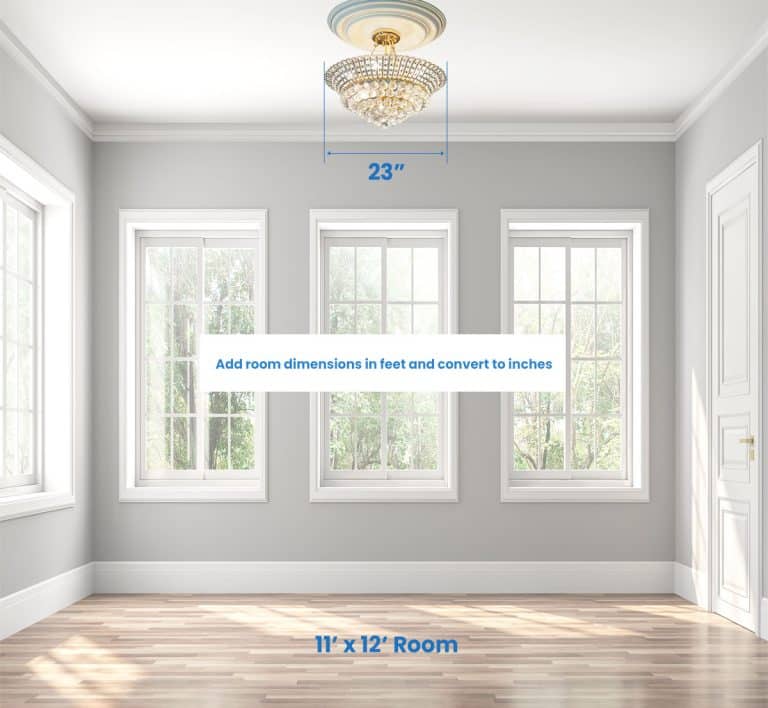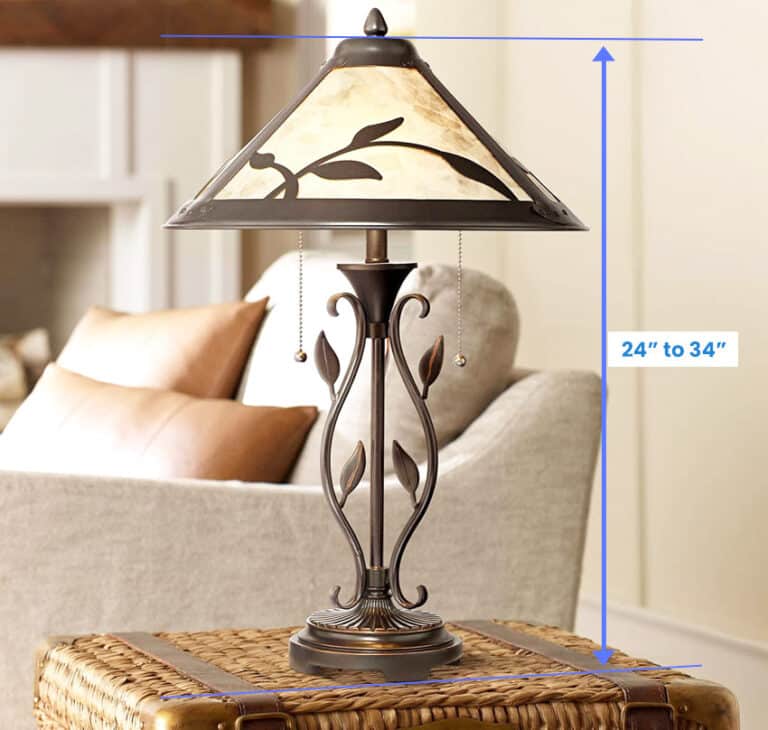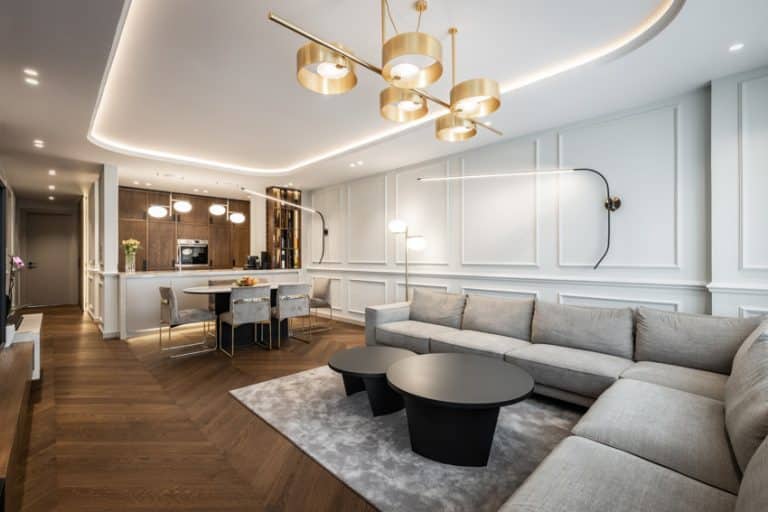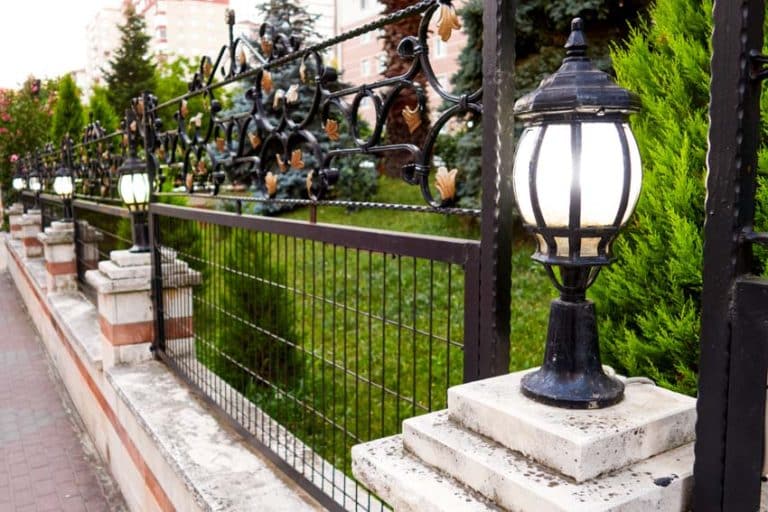25 Types Of Recessed Lighting (Housing & Trim)
Recessed lighting is a common type of house lighting that consists of lights installed inside a ceiling or wall. These fixtures, frequently known as can lights, pot lights, spotlights, or recessed lights, are among the most adaptable lighting selections available. Whether it is employed for wall lighting, down-lighting, or up-lighting applications, installing recessed lighting in your house could be both useful and appealing.
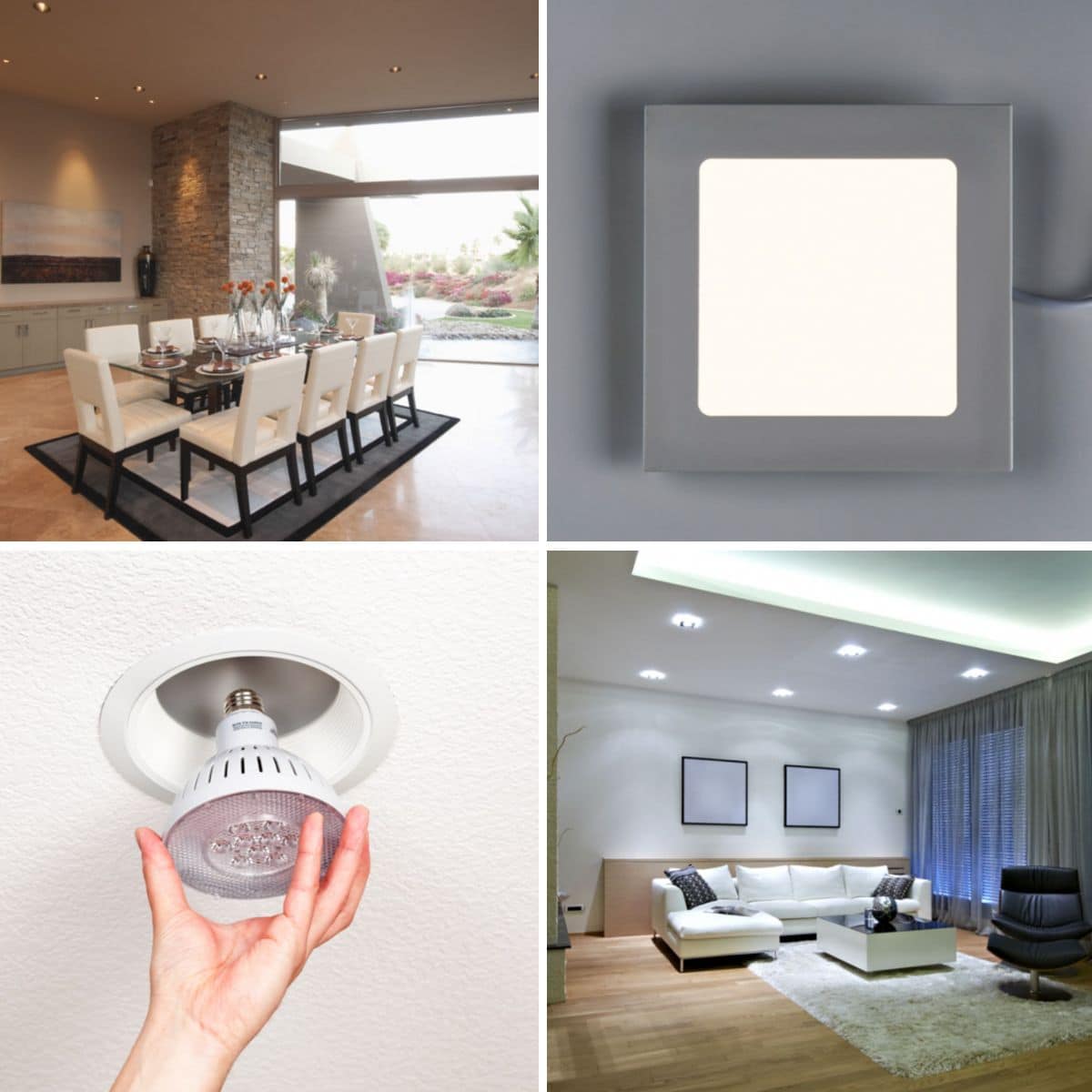
Moreover, they can be used to generate ambient lighting in a range of home and commercial settings as well as accent lighting for accentuating artwork, architectural elements, furniture, and other items.
With so many uses and displays available, it can be difficult to know what type of recessed lighting is the best for your well-loved home. In this article, we will discover the different types of recessed lighting you can choose from.
What Is Recessed Lighting?
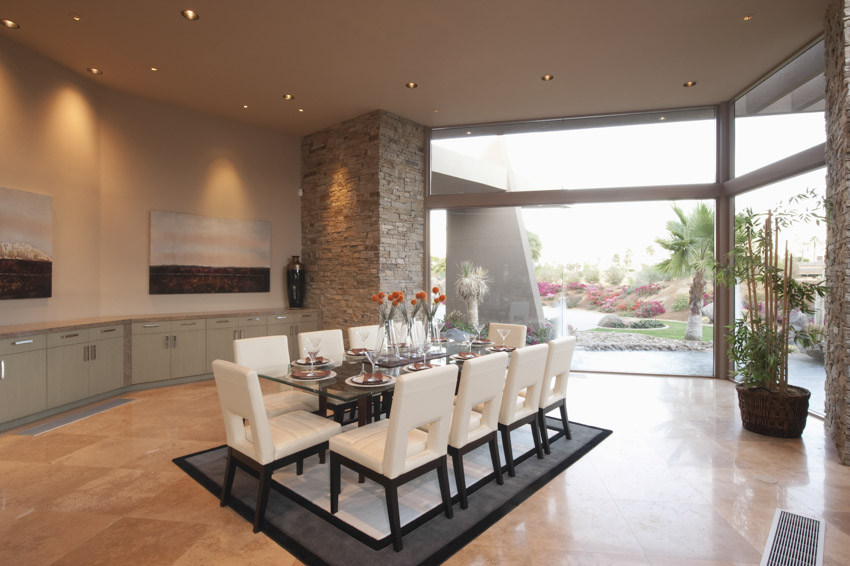
Recessed light is a type of lighting fixture that is fitted in a hollow aperture in the ceiling. When mounted, it purports to have illumination pouring from a hole in the ceiling, focusing the light downward as a vast floodlight or focused spotlight.

Furthermore, recessed types of ceiling lights are made up of three basic parts: the housing, the trim, and the bulb. The housing is the core of the fixture that is buried within the ceiling or wall and holds the fixture’s electrical components.
Recessed light fixtures are very popular for providing general lighting , specific task lighting , or for accenting rooms. – Popular Mechanics Complete Home How-to, Albert Jackson and David Day
The trim refers to the ornamental, visible element of the lighting fixture, which might incorporate shades, baffles, or reflectors. The last component is the bulb, which is the major element of the fixture that emits light.
Types of Recessed Housing
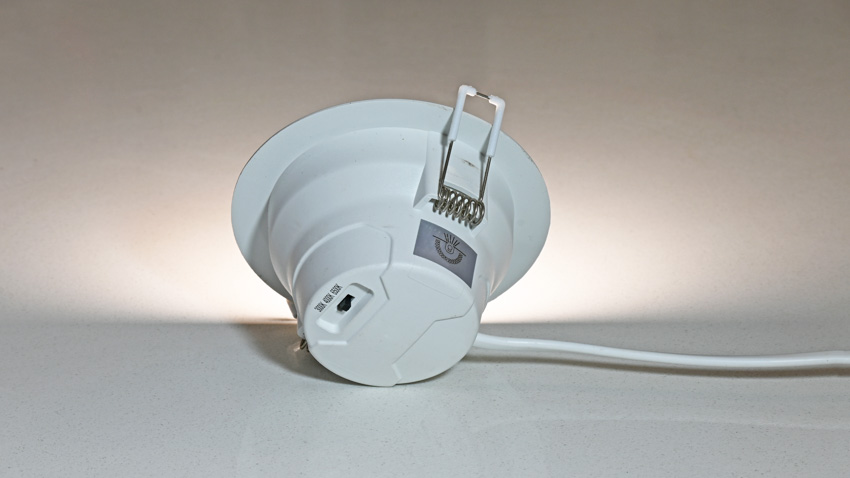
When purchasing recessed or can lighting, the first thing you should consider is the type of housing. The housing is the part of the lighting fixture that is attached to the wall or ceiling.
This fixture accommodates the light bulb. The trim is then applied to the exterior of the housing.
Your primary choices are new construction, remodel, insulation contact (IC), non-insulated (non-IC), low profile (shallow ceiling), airtight, and sloped ceiling light housing. Let us talk about each one of them.
New Construction Housing

New construction housing is designed exclusively for newly built houses. This kind of housing is laid in before the ceiling is finished.
To put it another way, it is already integrated into your house. New construction housing is also employed when building a new room in a current house.
Moreover, it is intended for use in areas with exposed ceiling joists and without drywall. Although they are most commonly applied on new constructions, they may also be used for renovations when entirely emptying a space.
Remodel Housing

The remodel recessed lighting housing is intended for installation into a pre-existing ceiling. A remodel housing is the best option if you have a ceiling with no visible joists or if you want to convert your present lighting system to LED.
Such housings are installed by inserting them into a small aperture in the ceiling and then securing them with clips. They are simple to install in almost any ceiling, including ones that were not designed with can lights in mind.
Insulation Contact (IC)

Each type of bulb or fixture produces a lot of heat. Can lights, in particular, is renowned for generating more heat as the housing is embedded within a ceiling, wall, or floor.
The housing with a recessed form is usually in touch with insulation. Your home is in significant danger of fire if the housing is not certified for contact with insulation.
Insulation contact-rated housing is developed as a result of this. They are constructed with extra heat protection to limit heat transmission from the housing to the insulation. Hence, there are no safety issues if your can light housing comes into direct touch with your insulation.
Non-Insulated Contact (Non-IC)
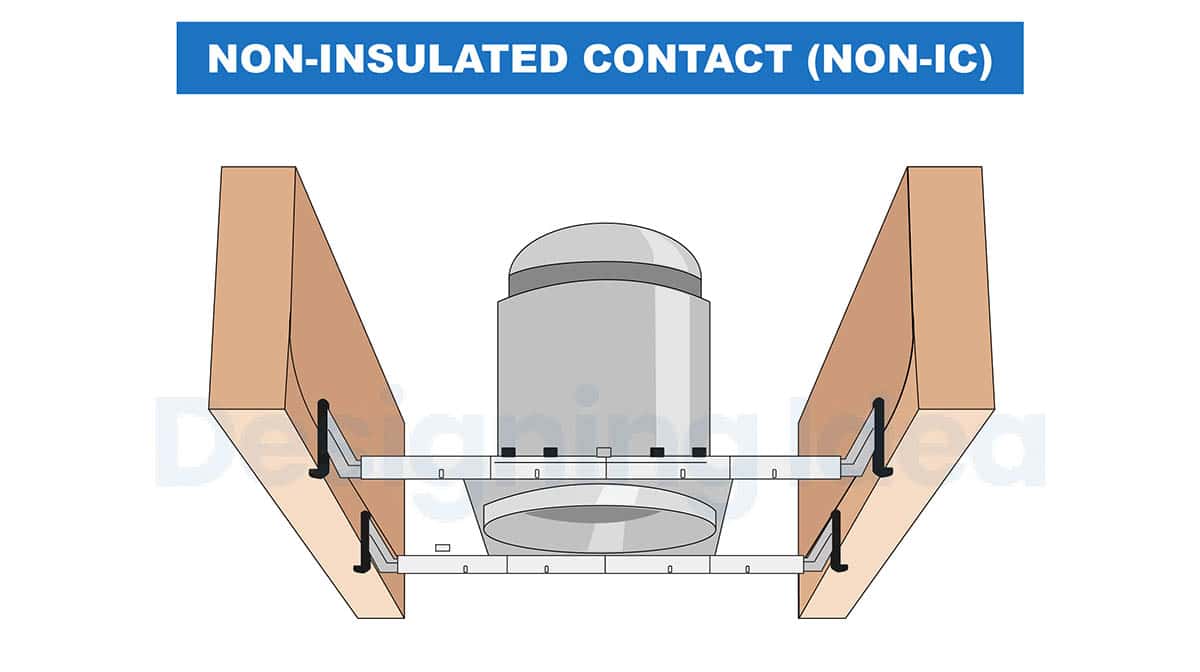
Non-insulation contact housing, as the name indicates, is not intended to impede heat transmission from housing to insulation. This type of can light housing must not be in constant contact with your insulation.
Non-IC rated housing, as opposed to Insulation contact housing, does not provide necessary heat protection. Thus, these housings are not often recommended for application in ceilings.
There should be at least 3 inches of clearance between the non-IC housing and the insulation above to utilize this type of housing.
Low Profile (Shallow Ceiling)
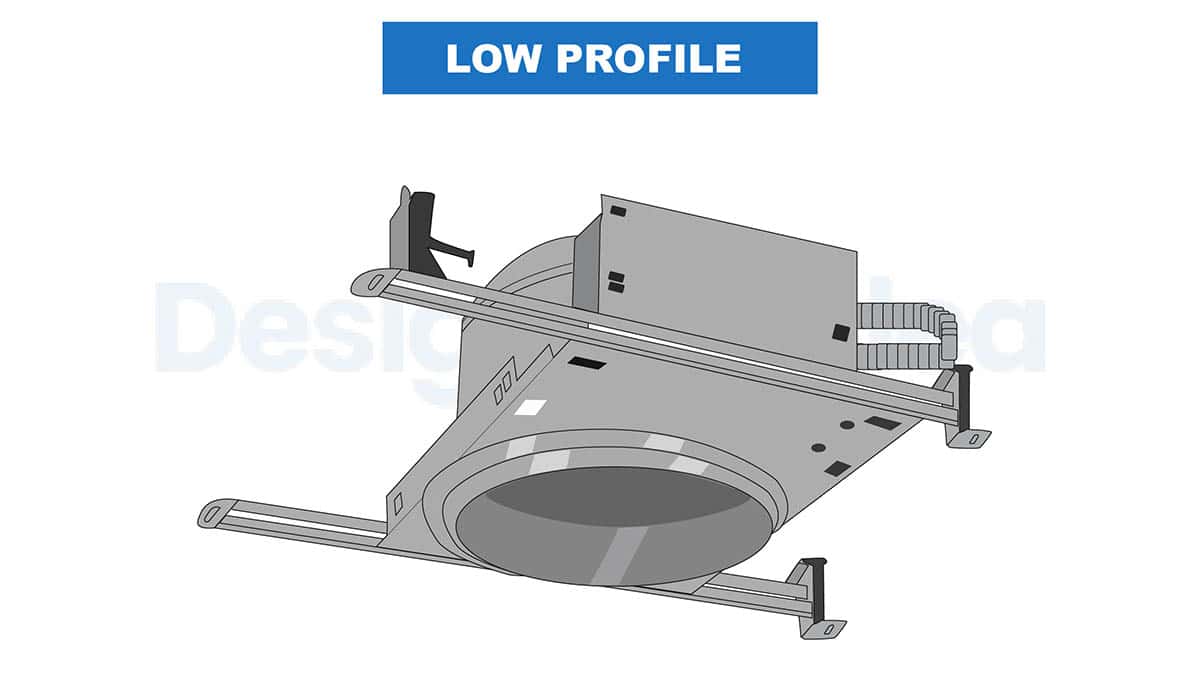
Shallow ceilings, or low-profile housings, as the name suggests, are intended for usage in areas with low ceilings.
However, not all ceilings have enough room behind them to accommodate standard can lights. This style of housing enables the installation of can lights in low-profile ceilings or those built with 2-inch by 6-inch joists.
Such kinds of ceilings necessitate the use of custom-built houses. There are other low-profile housing options available for ceilings with even less room.
Airtight: Recessed lights, apart from several other types of lighting fixtures, are mounted by drilling an opening in your wall or ceiling to allow the housing to lay flat.
Nonetheless, these gaps might pose problems. Even when the housing is firmly fitted into the opening, air could still permeate. This is when airtight housing comes in handy.
This style of can light housing is intended to prevent air from escaping from the light fixture. It accomplishes this by limiting airflow between the unconditioned region overhead (often an attic) and the conditioned region below.
Airtight housing also provides the optimum insulation, which means that neither cold nor hot air can escape when employing airtight housing.
The main advantage of employing this type of housing is that it increases your comfort level while simultaneously enhancing your home’s energy efficiency. Hence, when you utilize airtight housing for your recessed light fixtures, you can expect reduced monthly electricity bills.
Sloped Ceiling
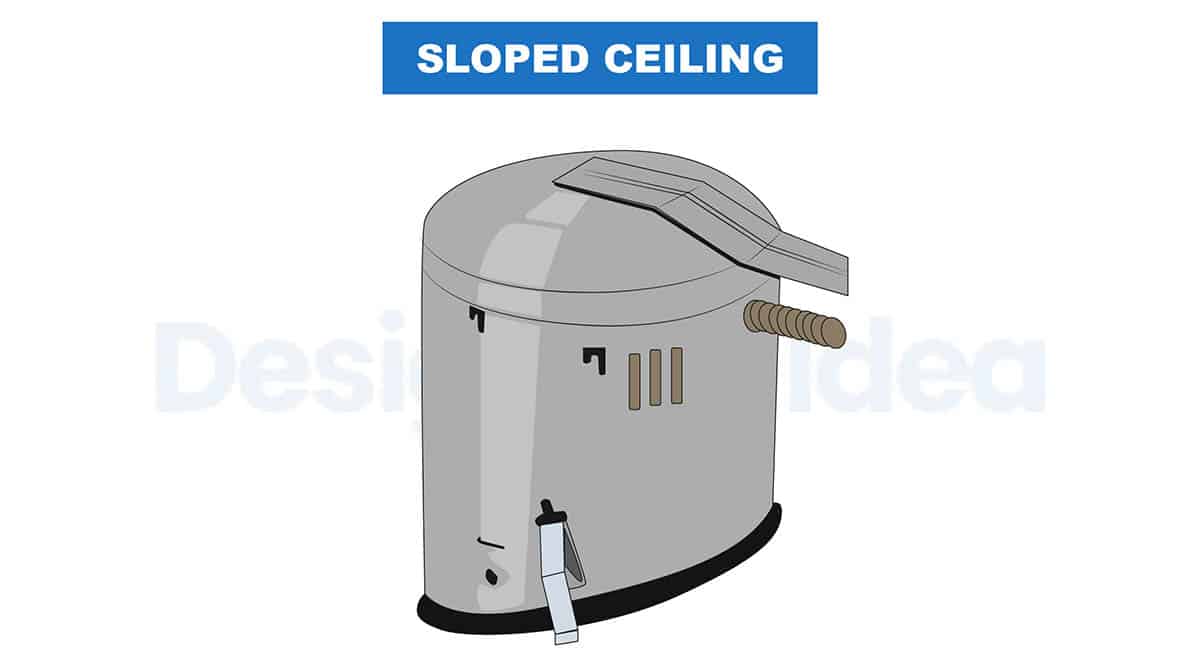
Although buying and mounting recessed lights on level walls and ceilings is pretty easy, it becomes more complicated when the ceiling is angled.
To incorporate can light into a sloped ceiling, you must employ a housing developed exclusively for these ceilings. Slanted ceiling housing is intended for sloped ceilings with space limitations.
Nevertheless, before you buy your sloping ceiling home, double-check the angles of your ceiling. Furthermore, you may get them checked by a professional before purchasing.
Types of Recessed Trims
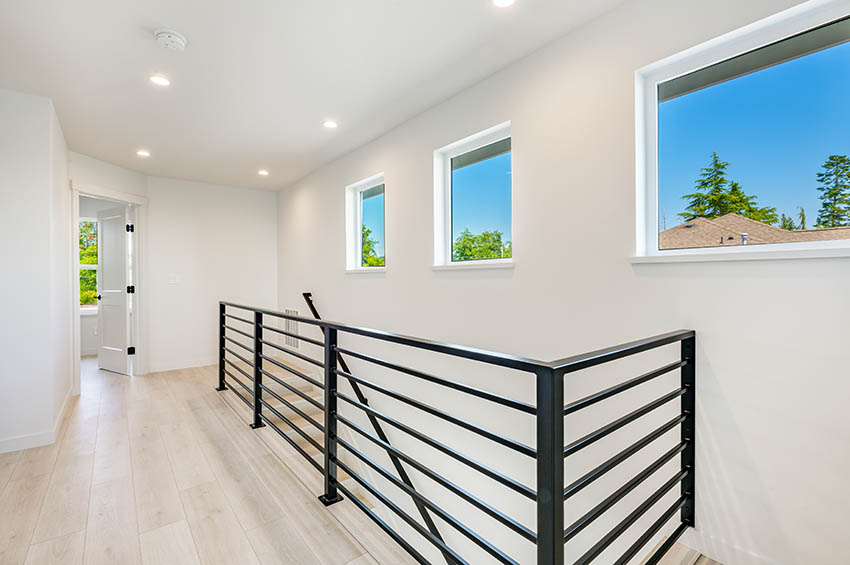
After understanding how to choose the ideal type of can light housing for your project, let us now talk about the trim.
Apart from the lighting source, the primary element visible to the naked eye is the trim. The remainder of the can light fixture, known as the housing, is hidden under your ceiling.
The trim lies inside the housing and protrudes to create the lighting fixture’s outer ring or molding. When choosing the proper trim, ensure it is the same size, manufacturer, and product category as your housing.
Moreover, consider the function of the light as well as the overall ambiance you want to accomplish.
That being said, there are several various types of can lights trim to pick from, each with its distinct set of advantages. Let us take a closer look.
Baffle Trim
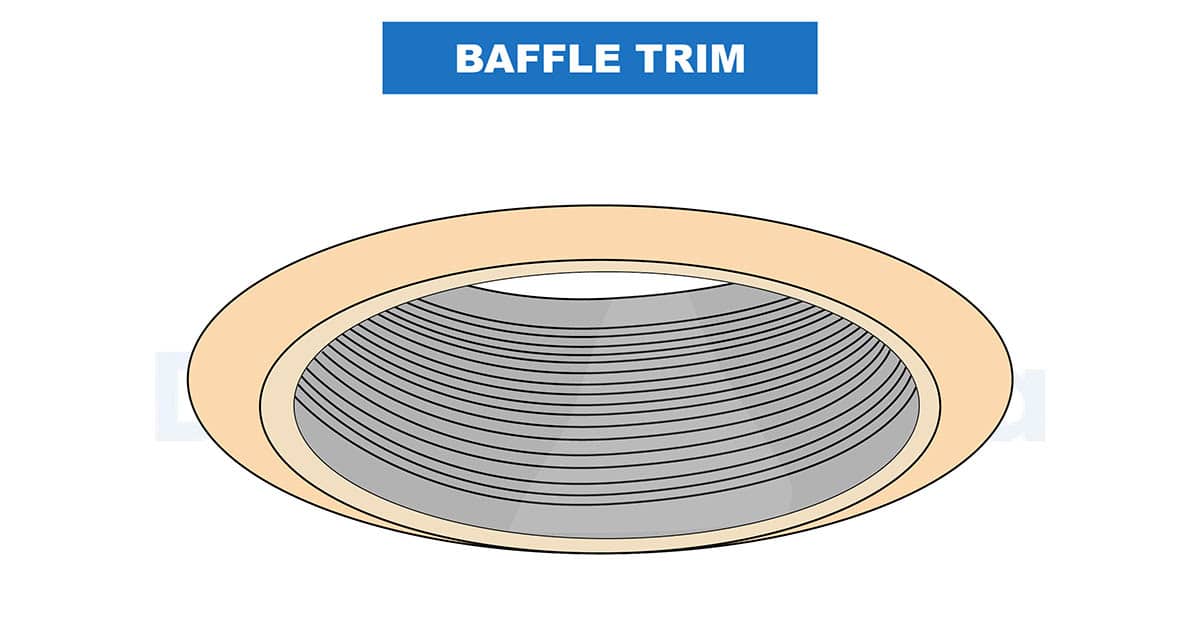
Baffle trims are likely the most prevalent form of can light trim manufactured. Because the light is directional, they are perfect for kitchens and home theater systems. This kind of trim is well-recognized for its ribbed inner component, which is intended to help prevent lamp glare.
Aside from that, baffle trim is popular in home office environments because of the soft and mellow illumination it emits.
For hotel lobbies, living rooms, and entryways, baffle trim is also ideal. To reduce glare, even more, choose a dark-colored baffle trim like dark brown, dark blue, or black.
Reflector Trim
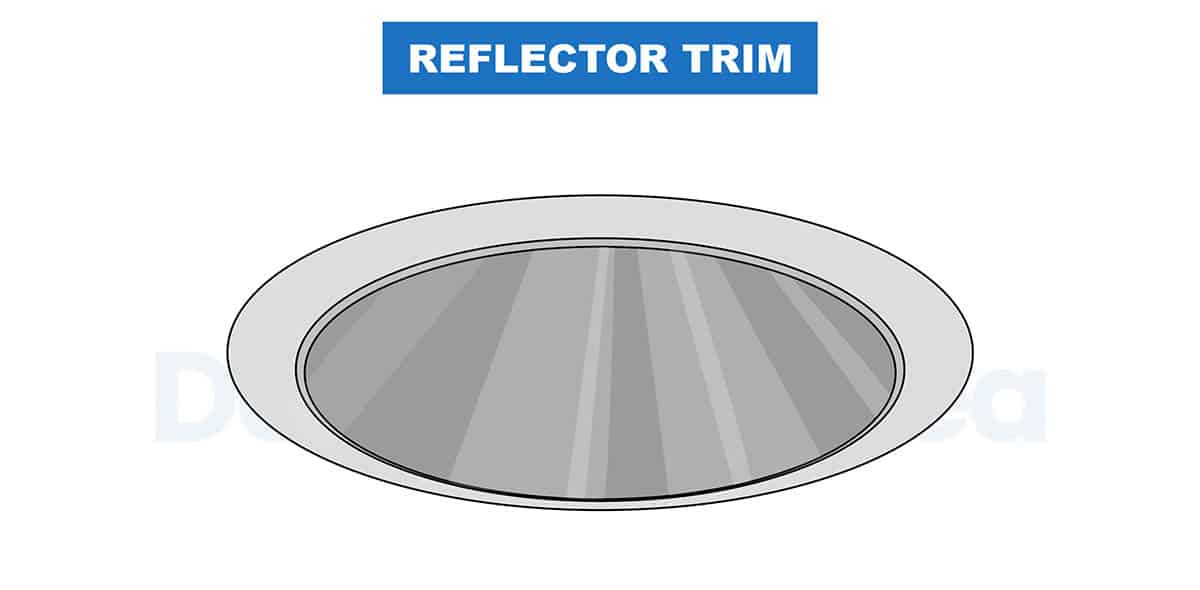
Reflector trims have a mirror inside that improves light-reflecting properties and enables excellent illumination. Such types of trims, like baffle trims, are embedded.
It is indeed vital to remember that the inner part of these recessed lighting trims is visible. This is particularly true for reflector trims since the reflected surface will be highly visible.
Thus, you may choose to get a recessed light with a tinted mirror inside. This option is easily accessible.
Open Trim
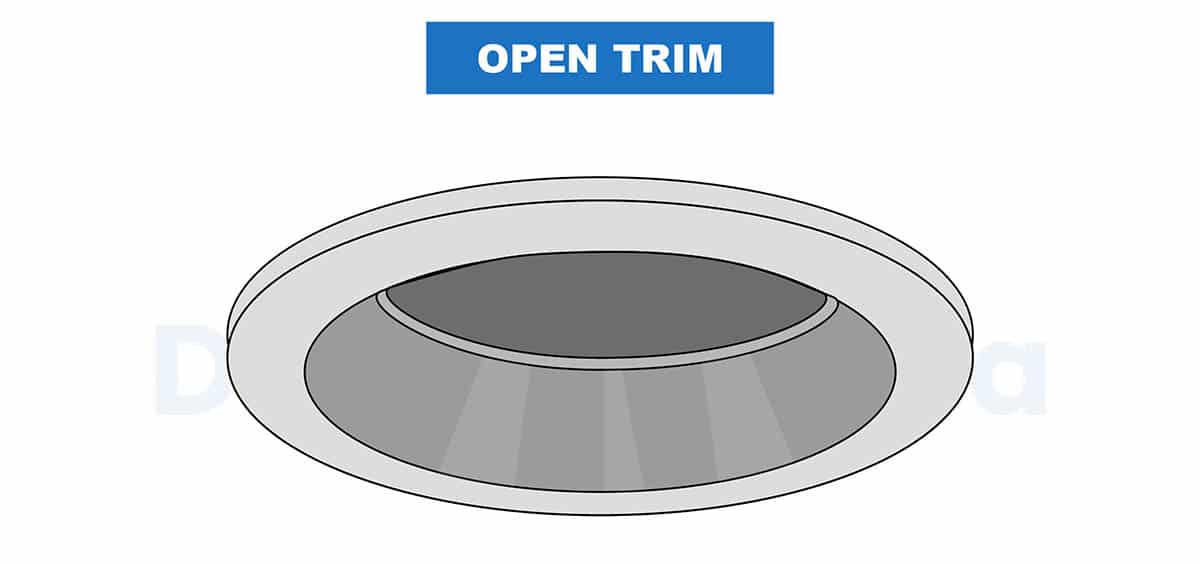
Recessed lights with an open trim appear identical to lighting with a baffle trim. The main distinction is that it lacks a ribbed interior.
Open trims do not minimize glare without this function. The primary benefit of this type of recessed light is that it provides more luminous illumination.
The light is flush, or nearly so, with the ceiling. Open trim lights are perfect for lighting up massive spaces. To increase brightness, you must choose a light-colored open-trim recessed light such as soft yellow or white.
Eyeball Trim

Eyeball trims have the same appearance as open and baffle trims, but with the extra benefit of being movable and adjustable.
Eyeball trim, also known as adjustable trim, enables you to modify the inner light fixture to customize illumination in your living areas. Gently rotating the light fixture allows you to direct the light precisely where you want it to beam.
This trim is best suited for accent lighting instead of ambient lighting. Because so much trim is apparent on certain eyeball trim models, they might be considered unattractive.
When selecting recessed lighting with eyeball trim, choose a hue that complements your room’s overall décor and aesthetic.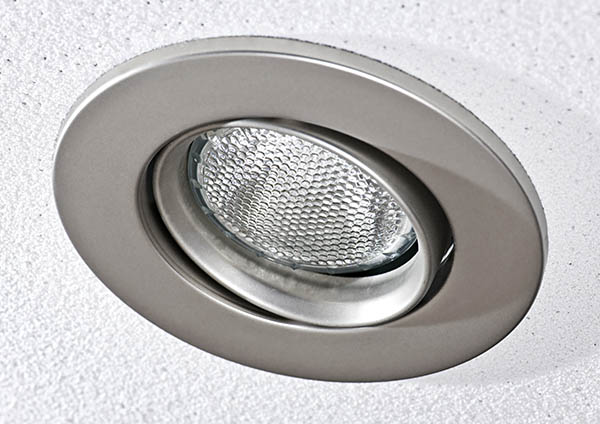
Gimbal Trim

Gimbal trim acts essentially identically to eyeball trim. The primary distinction between the two is that the light bulb in recessed lighting with gimbal trim is generally level with the ceiling. Hence, when the fixture is rotated, the housing obstructs portions of the light.
They are pivotable to offer directed lighting. Gimbal trim recessed lights, in particular, direct downlight precisely where it is required. This kind of trim is perfect for emphasizing accent walls and sloped ceilings in a house.
Wall Wash Trim
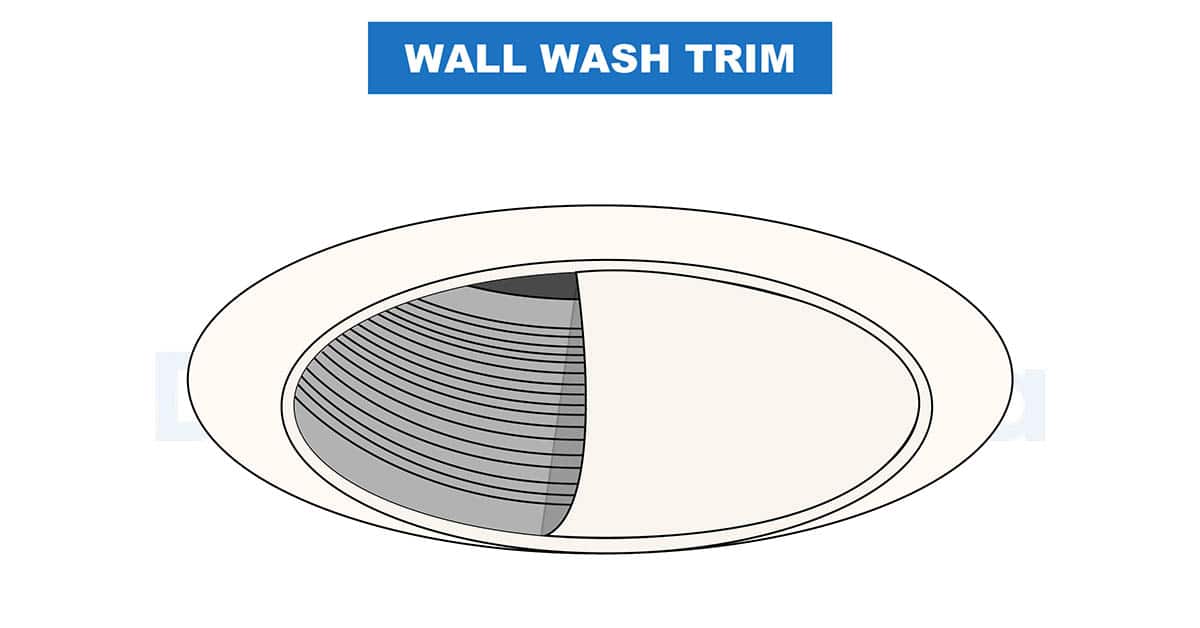
Wall wash trim is a hybrid of the baffle and eyeball designs. The appearance is identical to the baffle, with the added benefit of permitting you to customize the light fixture according to your preference.
Aside from that, there is a half-shield that partly hides the light’s aperture. This shield aids in evenly focusing the light beam on certain areas in your living areas.
The said shield resembles a “scoop” that directs light to a specified location. Accent lighting and highlighting artwork, architectural elements, or pieces of furniture are suitable uses for this type of recessed lighting trim.
Pinhole Trim

A broad trim distinguishes the style of pinhole trim recessed lighting. As a result, a narrow, focused light beam is produced. Accent lighting is great for pinhole trims. They are very useful for highlighting an architectural component or a particular design aspect.
Shower Trim
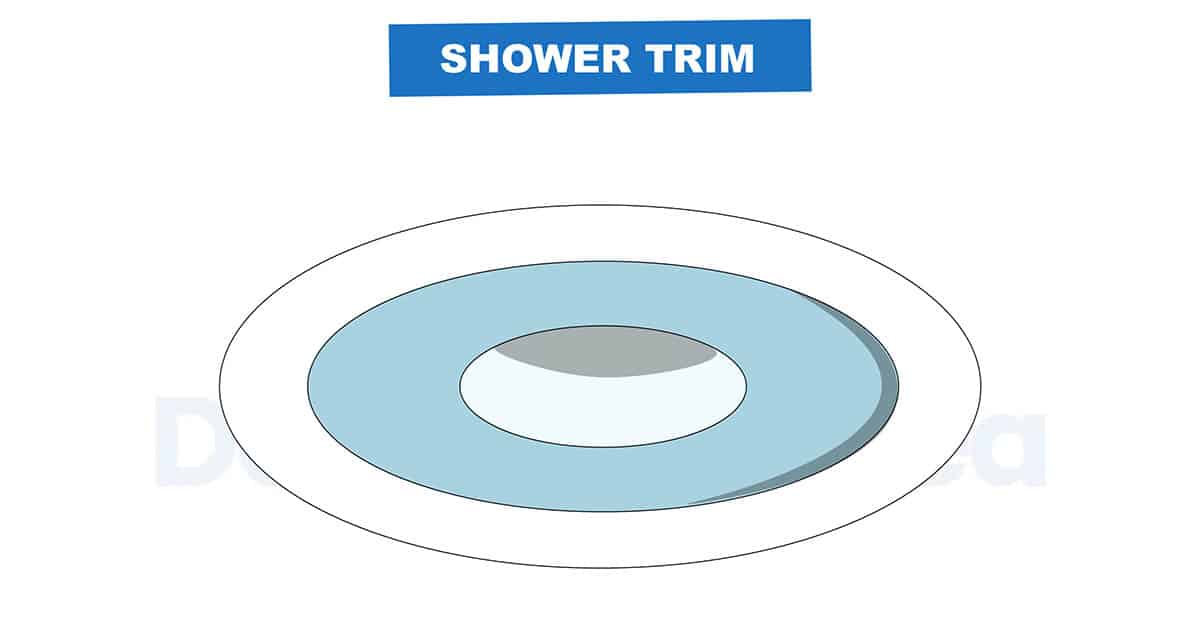
Shower trim, as the name implies, is an excellent solution to illuminate the interior of your shower. Shower trims are ideal for bathrooms or other spaces that encounter high humidity conditions.
They are generally made out of tempered glass, which protects the lamp from water and avoids fog buildup inside the fixture. Shower trim recessed lighting is indeed perfect for damp environments.
Canless
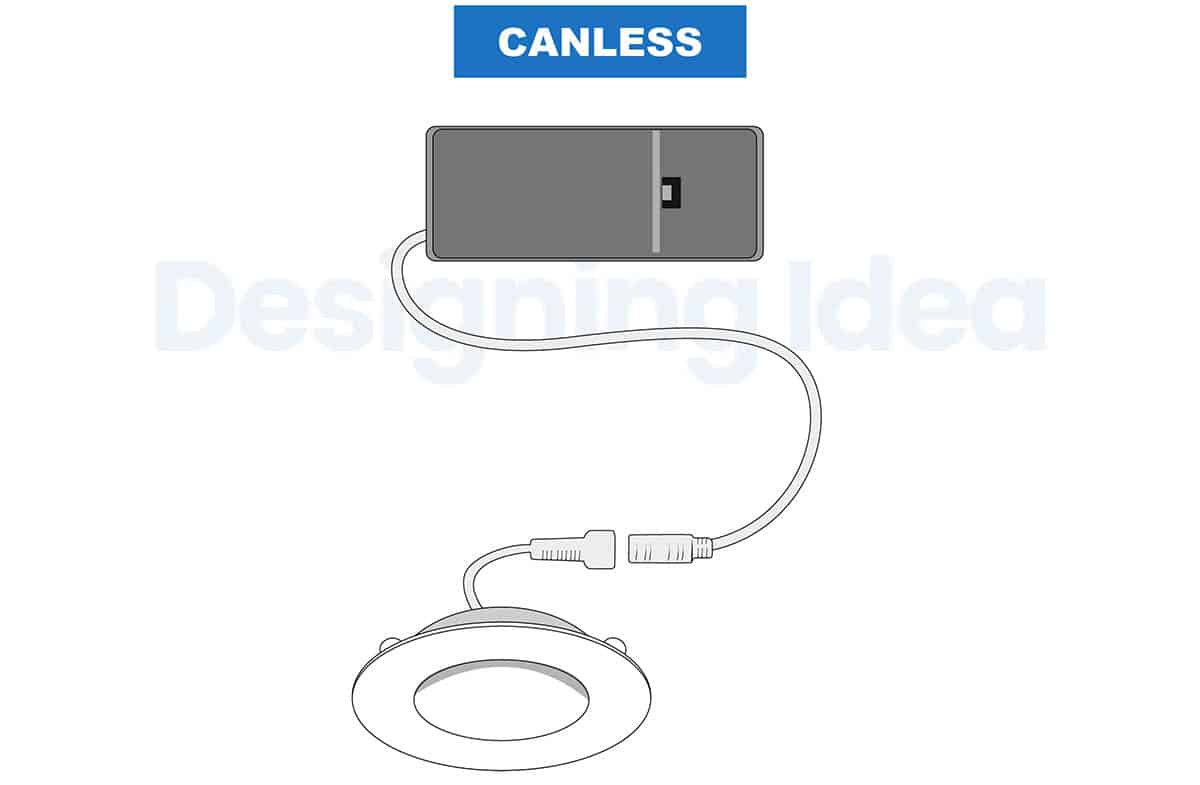
A canless trim is a single unit that attaches directly to the electrical cables in your home. They do not necessitate the use of an electrical box.
Canless recessed lighting operates without canisters or housings to retain the bulb. They are often thin or ultra-thin, with LED lighting incorporated into the system. They are small and can fit into narrow areas.
Slotted Trim
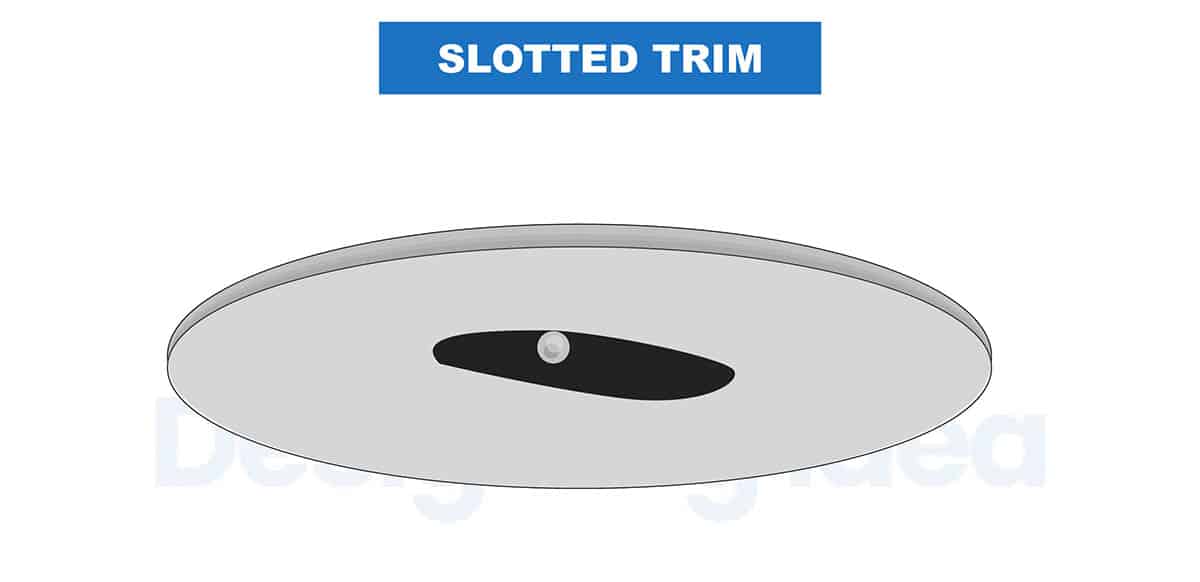
Slotted trims are roughly comparable to pinhole trims in the way that they provide thin light angles. When it pertains to recessed lighting, they are the most unobtrusive selection.
Except for a tiny opening with a flat trim, slotted trims conceal practically the whole light. They are also famous for their 35-degree tilting ability and customizable rotation.
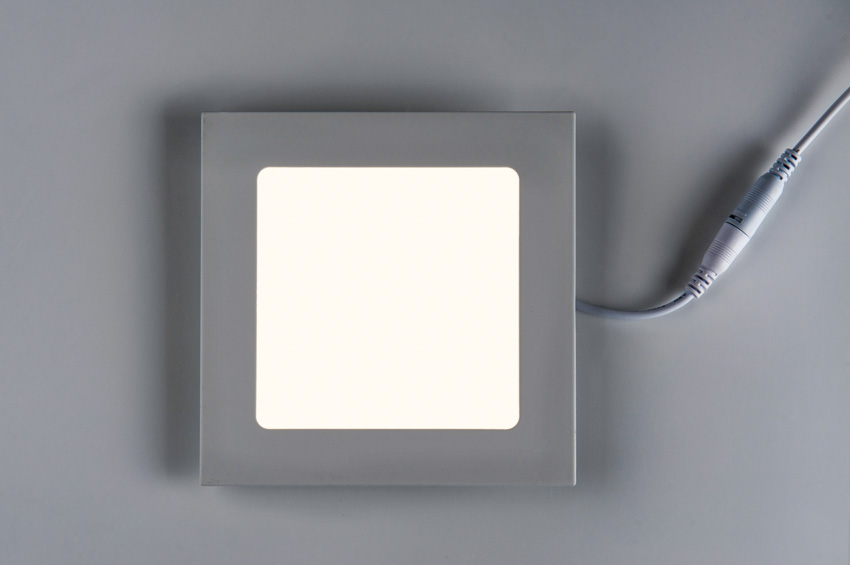
Square
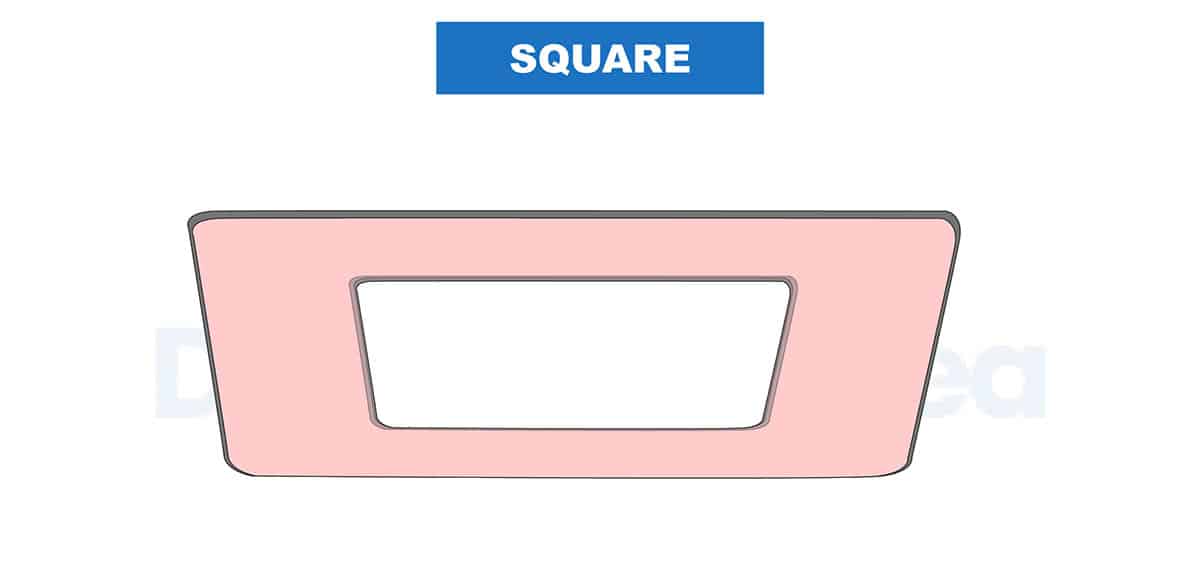
Recessed lighting with square trims are fashionable types of ceiling lights that instantly add a modern touch to your house.
Square recessed lighting is typically used in low-profile regions of the home and works well when layered with other lighting fixtures.
Square trims are a popular selection for in-ceiling lighting, with styles ranging from extremely ornamental to more practical than attractive. Aside from that, whether you are working on a renovation project or starting from scratch, you will discover recessed trims that are ideal for your needs.
Decorative Trim
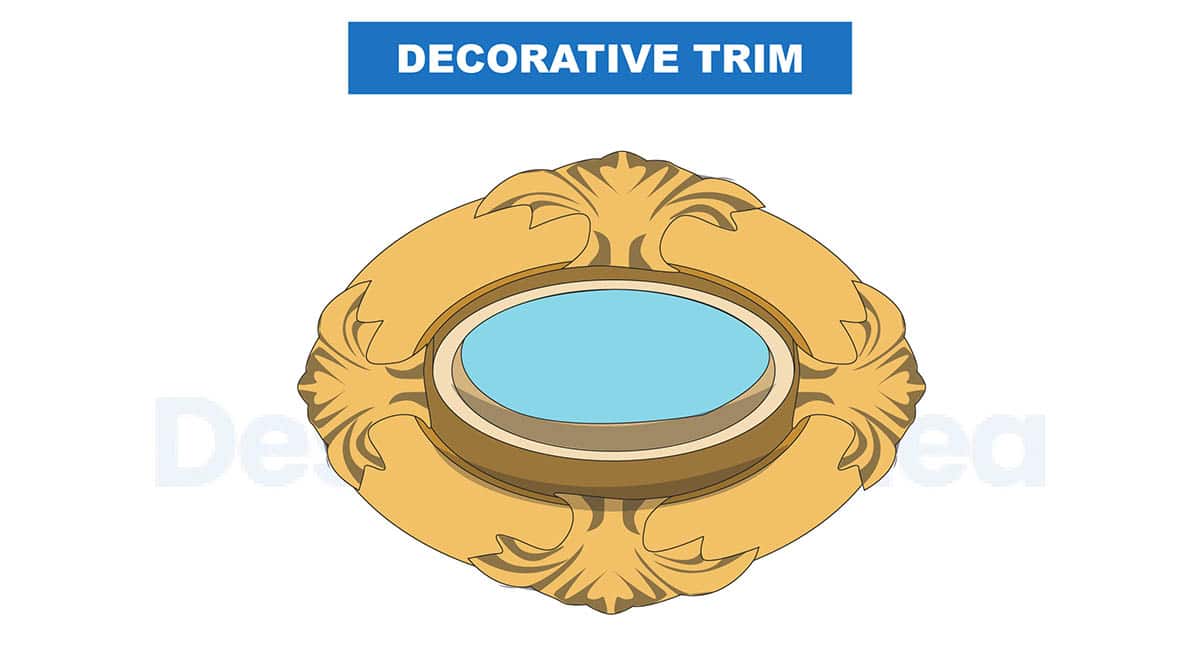
Recessed fixtures, while commonly thought of as a strictly practical type of ceiling lighting, can also be decorative. Decorative recessed lighting trims give a visible splash of color to the ceiling while also providing plenty of overhead lighting.
With complex designs and exquisite patterns, this kind of can lighting is equally as attractive as magnificent pendants or a modern chandelier.
Simply put, ornamental trimmings provide an elaborate twist to standard recessed lighting. They are available in a variety of choices, patterns, and styles to match the décor of your room.
Trimless Recessed
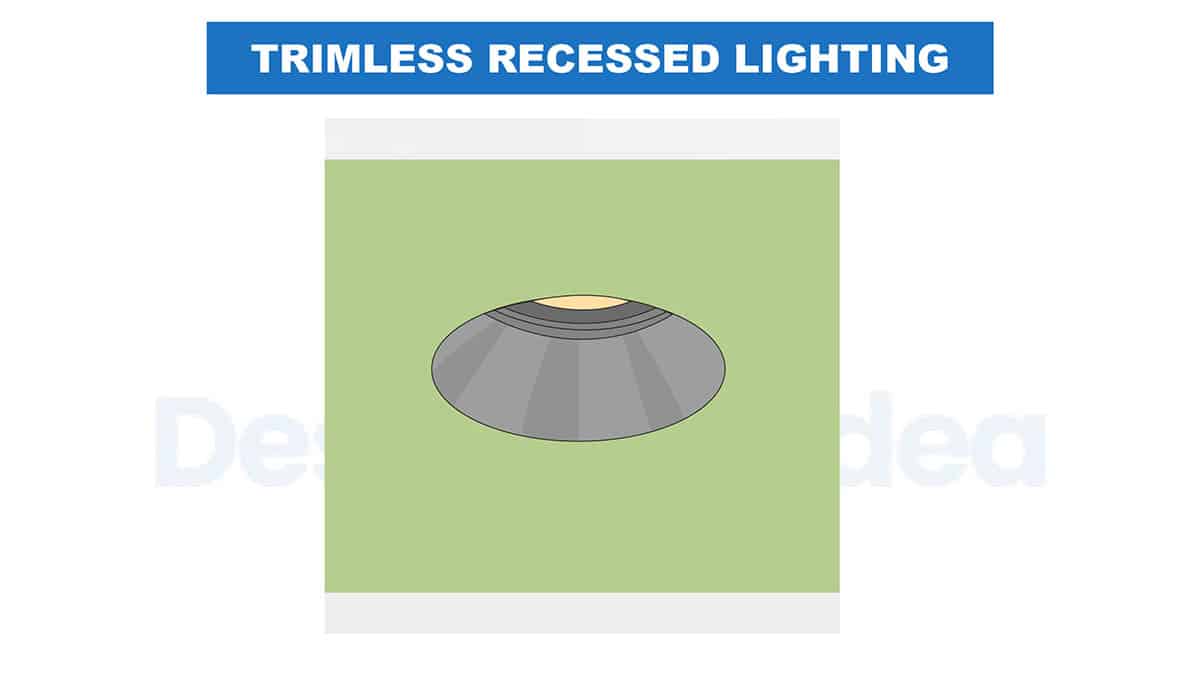
Trimless recessed lighting is frequently recommended by interior designers. Trimless recessed lighting is a type of recessed lighting that does not have a noticeable trim ring.
The adaptability of this lighting is linked to its architecture, which often includes an adjustable gimbal lighting source that allows the user to control the light beam.
One of the most popular fallacies regarding trimless recessed lighting is that it is trimless. However, there is actually a trim; it is just not visible. This trim is affixed to the ceiling.
The lights are hidden away with no visible trim, appearing to be incorporated into the ceiling, providing a polished and luxurious appearance.
Types of Light Bulbs Used

In terms of selecting the correct lamp or light bulb, for your recessed lighting, you should consider both the style and size of bulb that your specific fixture requires.
Certain recessed lights employ pin-base bulbs, while some use screw-in light bulbs. Lumens, color temperature, and voltage all influence the lighting quality in a room.
The lights are usually supplied individually from the housing and trim. Halogen and LED bulbs are the most frequent types of recessed lighting fixtures.
While most current recessed lights are in-built LED, which means no lamp is required, non-LED recessed lighting can also come in various designs.
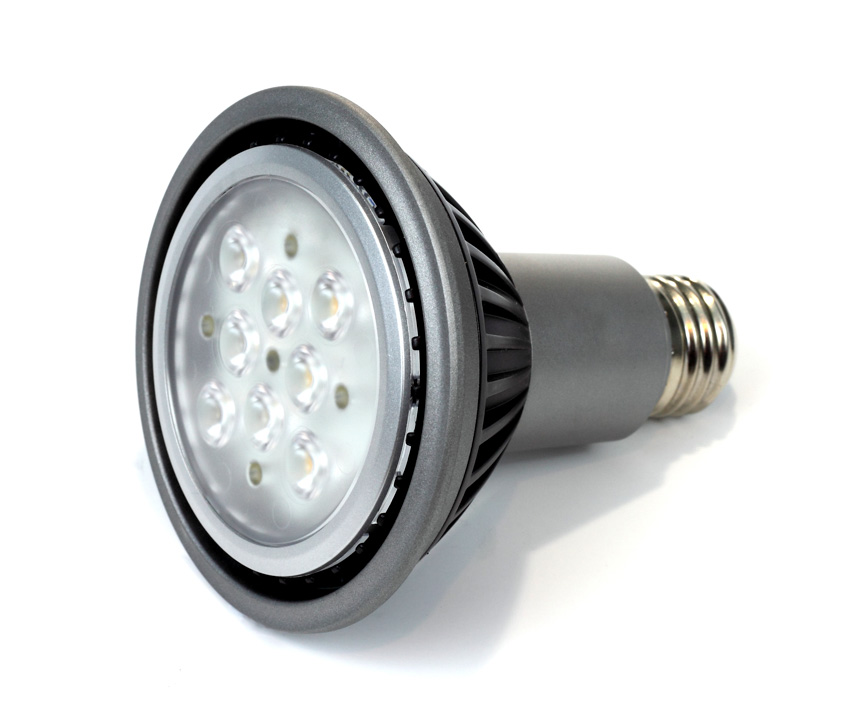
LED Light Bulbs: LED bulbs are undoubtedly the most energy-efficient light bulb variant available in the market. While CFLs save 75% more energy than standard incandescent bulbs, LED lights could save up to 90% more energy.
LED light bulbs are an excellent selection for recessed lighting due to their incredible durability and prolonged lifespan.
CFL Light Bulbs: Another common alternative for recessed lighting is CFL or compact fluorescent light bulbs. These, similar to LED lights, are an excellent energy-saving option.
In actuality, they are a variation of standard fluorescent technology, which was initially designed as an energy-efficient substitute to regular incandescent lights.
Moreover, one significant advantage of these light bulbs is that they have extended longevity. While they are more expensive than incandescent bulbs, they may last up to 10 times much longer. One of the biggest disadvantages of CFLs is that each bulb contains a minimal quantity of mercury.
When the light bulbs are in operation or are still undamaged, no mercury is discharged. While mercury may ultimately get up in the environment, the quantity will be considerably less than the amount avoided due to energy conservation.
Incandescent Light Bulbs: When most people think of a light bulb, the picture of an incandescent bulb comes immediately to mind.
In reality, this was the very first type of bulb ever developed, making it the earliest form of electric illumination. They have been in use for almost a century.
An electric current flows through the tungsten filament within incandescent lamps to power them. This allows the filament to heat up to a temperature high enough to produce light.
Although more modern and energy-efficient alternatives are gradually surpassing these bulbs, they can still be used in can lights. The biggest benefit of using a classic incandescent bulb is its very affordable cost.
Halogen Light Bulbs: Halogen bulbs, similar to LED lights, are an extremely common form of bulb utilized in can light applications. While this is mostly owing to their energy efficiency, it is also because halogen lamps provide a very strong white light.
They are comparable to incandescent bulbs in terms of light distribution and functionality. They are, nevertheless, around 30% more efficient and last far longer than standard incandescent bulbs. Halogen lamps produce greater light while using significantly less power.
These light bulbs come in a variety of sizes, particularly spotlight and floodlight kinds, to best match the needs of various lighting setups.
R-Type Light Bulbs: R-type light bulbs, often known as R lamps, are widely used to provide exceptionally directed or intensified illumination. The reflector at the rear of the bulb is the key reason for their appeal.
Aside from that, its design provides excellent illumination by directing it uniformly out of the fixture. Thus, R lights are an excellent alternative for achieving accent lighting in a particular area.
Recess Light Materials
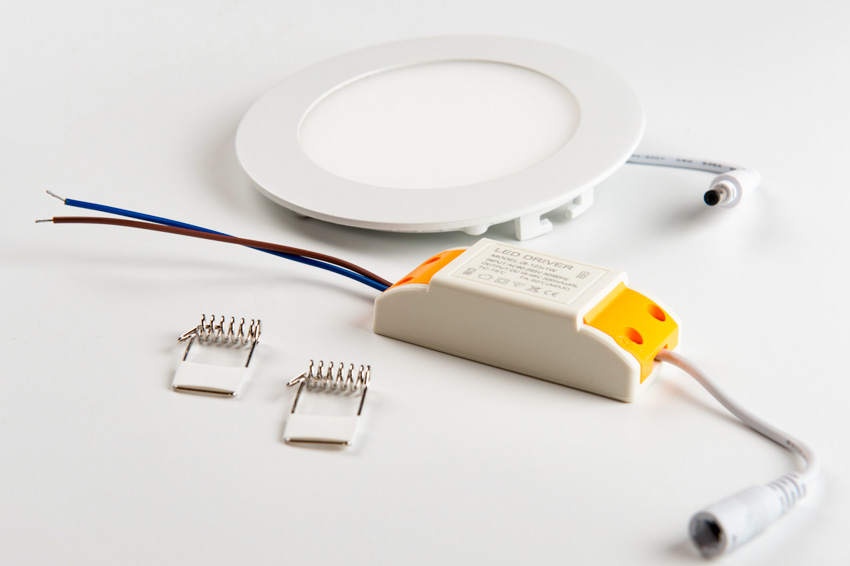
Due to the direct proximity of the hot light bulbs within, the housing is nearly typically composed of heat-resistant materials. Below are some of the most common materials used for can light:
• Metal
• Treated Plastic
Treated plastic and metal are just some of the most common materials used for downlights. However, any material with a very minimal fire risk is frequently used in can lights fixtures.
The same statement applies to downlight trims. Although there is greater flexibility in terms of materials here, you can guarantee that any material utilized is heat-resistant.
Recess Light Finishes
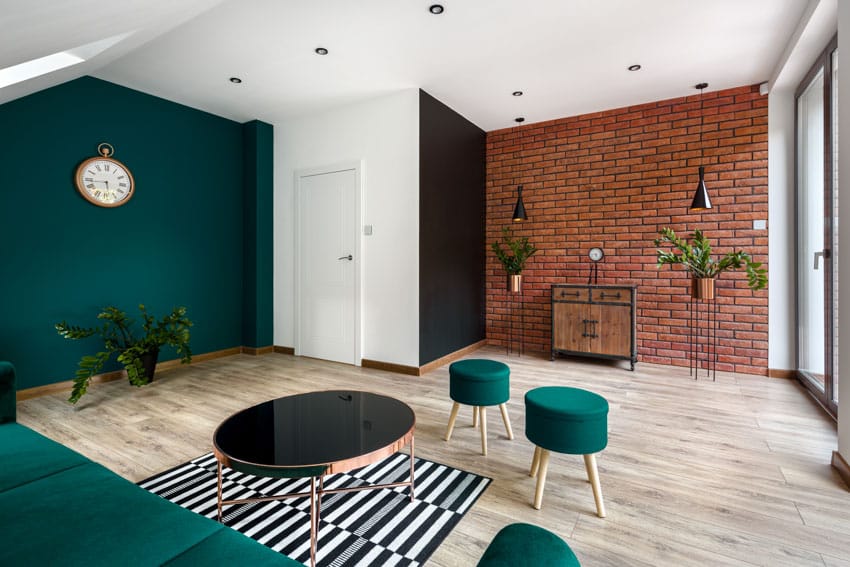
Another factor to take into account while browsing through the numerous varieties of downlights is the finish you prefer. In general, it is better to base your selection on the current finishes inside your house.
If all of the hardware and doorknobs in the room are brushed nickel, use a trim with a more modern finish. Nevertheless, if you want your recessed lights to merge in with the surface of your ceiling, white is usually the ideal choice.
The following are some of the most common trim finishes for downlights:
• Silver
• Bronze
• White
• Nickel
• Black
• Chrome
Luckily, if you wish to update your room or freshen up your design, you can replace the trim with a new finish without needing to replace the housing behind it.
The most common trim size is 6 inches; nonetheless, 3 and 4-inch trims are also obtainable in a variety of finishes.
Downlights might give unobtrusive and efficient lighting that fits perfectly into your architecture, or it can create startling points of aesthetic value in your house, depending on your distinctive preferences.
With a better comprehension of all the different varieties of downlights, you can now go on with all the information you need to get the aesthetic you want.
Recess Ceiling Lighting Sizes

Recessed light fixtures are typically 3 to 6 inches in diameter. However, some recessed light sizes can be as large as 7 or 9 inches. The size you select is totally dependent on how you intend to use the fixture and where it will be positioned.
Compact recessed lights are an excellent option for modern interior design. They can also be used for both task and accent lighting such as above-countertop lighting in the kitchen.
Recessed lights in the 6-inch spectrum are most commonly used for ambient lighting. Larger light fixtures, on the other hand, complement more classic décor and are perfect for lighting a whole space.
To identify the size of a fixture, determine the diameter of the surface that will be entering into the aperture in your ceiling in inches, without involving the trim. Afterward, select a recessed lighting size that corresponds to the height of your ceiling or the width of your wall.
Whenever deciding on the proper size of your in-ceiling light fixtures, consider the height of your ceiling. Lights set at higher ceilings cast a significantly broader, more scattered light spectrum than those put in lower ceilings.
Lighting Options
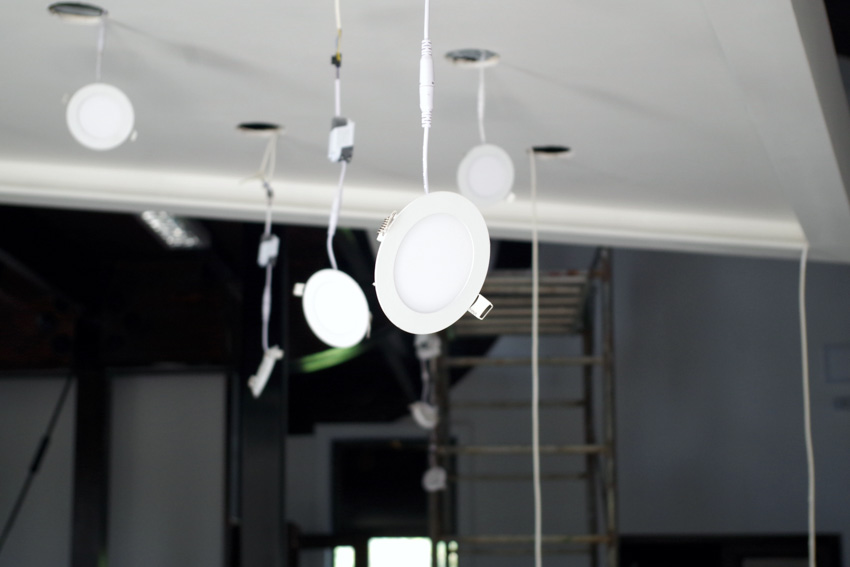
Here we share the different options for in-ceiling light fixtures.
Dimmable: You can adjust the atmosphere of a room using a dimmer switch. You just need to be sure to use a suitable switch for your recessed lights. This feature is helpful for areas where you want to control the mood such as lighting the dining room, bedroom, bathroom or kitchen.
Dimmable in-ceiling lights are a great option as they allow you to adjust the lighting intensity to meet your preferences.
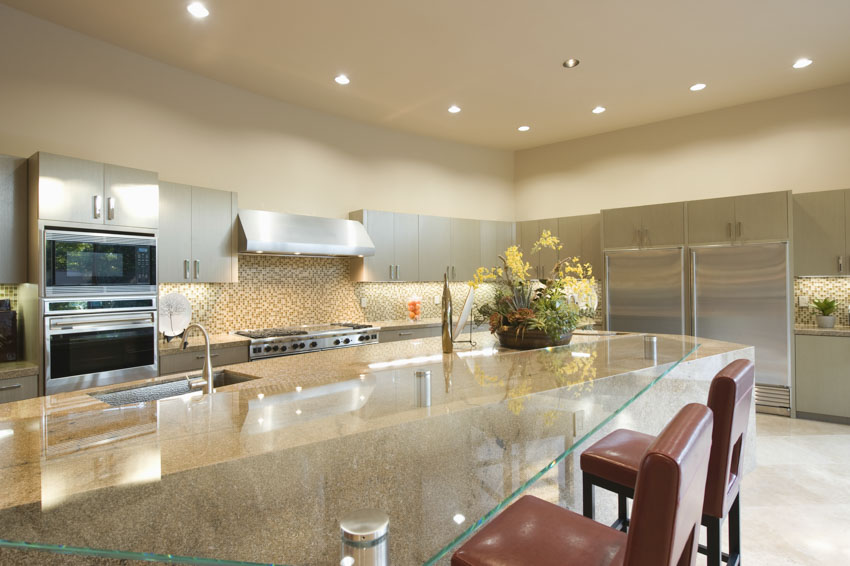
Color Temperature: In terms of color temperature, you can use a warm white tone for most types of room in a house and living spaces. A bright white color temperature is one of the most suitable for kitchens and workshops, whilst daylight color temperatures are best suited for reading areas.
In-ceiling light fixtures are available in 3 color temperatures – soft, daylight, and bright.
The soft setting offers a pleasant light with a warm hue. Daylight is intended to resemble natural illumination. Furthermore, the term “bright” in bright lighting refers to invigorating light with a cool radiance.
Configurable lighting can be used for unique setups. This enables you to change the color or temperature of the fixture whenever you want.
You can also control the lights with your smartphone or other smart gadgets. Customizable lighting, on the other hand, allows you to pre-set several temperatures before installation.
Wireless: The best feature of wireless dimmer technology is that it does not necessitate the installation of additional wiring.
In the marketplace, there are numerous terrific choices for wireless lighting controls. In bedrooms, the switch controlling the lights is often located on both sides of the bed, while the dimmer is normally near the door.
Adjustable: The lenses of adjustable recessed lights are somewhat recessed and linked to an axis that enables it to tilt within the trim, often up to 35°.
On the other hand, fully adjustable recessed lights could be adjusted from flat to around 70° and can rotate 360°.
They provide the most versatility in terms of accent and artwork emphasis, but they overhang from the ceiling, making them considerably more conspicuous than a conventional adjustable recessed light.
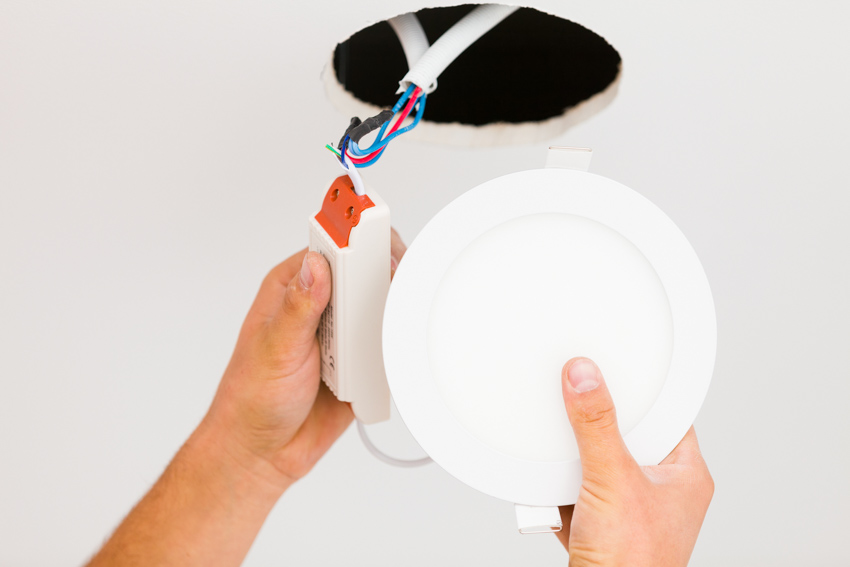
Recessed Lighting Kits: Consider getting a in-ceiling light kit to have both the housing and the trim in one package. These kits are available in a multitude of sizes and in-ceiling light styles to meet your specific requirements.
When it comes to in-ceiling light kits, line-voltage kits are the industry standard. They utilize the same 110 to 120-volt home power as any other form of ceiling light.
On the other hand, low-voltage kits employ a transformer to shift the standard electric current in your home to a considerably lower voltage. which is generally 12 volts. This reduces energy expenditures but is more costly to acquire initially.
Low-voltage setups, overall, provide a substantially more regulated beam of light. Though some of these kits include a transformer, others need you to purchase one individually.
However, LED conversion kits enable you to convert classic incandescent recessed types of lighting fixtures to LED without needing to replace the current housing.

Hue Recessed Lights: Hue smart lights may be used in in-ceiling light fixtures. Simply select one of 2 different hues recessed light sizes: the hue 4-inch fixture, which provides warm to cool white light, or the 5- to 6-inch fixture, which provides the complete spectrum of white and colored illumination.
Color Changing: Homeowners may use a compatible device app to change the color temperature of the light- either a warm or cold color environment.
Warm lighting is more yellow, offers a lower temperature, and tends to showcase lamplight shades.
Cool lighting, however, offers a greater temperature and is more comparable to natural sunlight. In terms of choosing whether to showcase warm or cold lighting, there is no right or wrong answer, but with smart color-changing lighting options, you can experience the best of both worlds.
Covers: Covers are frequently in the shape of a trim ring and are obtainable in a myriad of colors and metallic treatments. An ornamental cover can be square, which is ideal if you find circular covers too basic, boring, or typical.
Aside from aesthetics, the trim ring or light cover for in-ceiling lights has another function: it covers the place where the can lighting and ceiling meet to produce a smooth transitioning between the lighting and the surface.
Recessed Light Speaker: A recessed light speaker can be easily mounted into your existing recessed housings and gives both bright light and high-quality sound. You can play music on it anytime you want via Bluetooth.
Motion Sensor: A motion sensor is a device that senses movement and is also found in some forms of in-ceiling lights. Today, it is possible to discuss recessed light with motion sensors since it is a mix of two technologies that can make life easier for homeowners.
The recessed light with motion sensor detects movement 24 hours a day and, when paired with a network connection, the lighting can be operated by remote, monitor, and delivering orders to the light in perfect sync.
Installation Costs
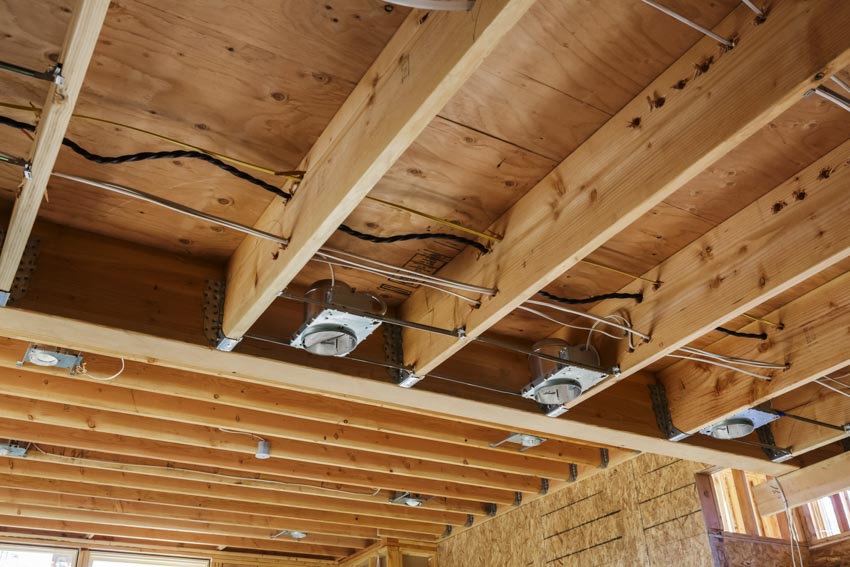
If you get your in-ceiling lights mounted by a professional, you will likely pay around $100 to $500 for each fixture, or $350 on average.
The project costs roughly $2,200 on average for 6 fixtures. The overall cost, however, mainly depends on the kind of housing, trim, and bulbs you choose.
How to Install Recessed Can Fixtures
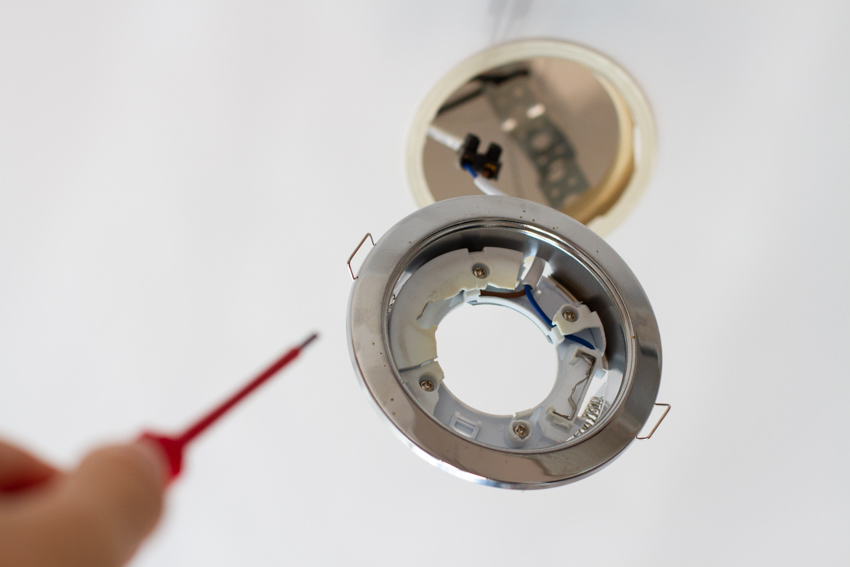
Here are the tools you’re going to need:
• Recessed light
• Electrical cable
• Wire ripper
• Wire stripper
• Hole saw
• Side-cutting pliers
• Voltage tester
• Breathing protection
• A huge piece of plywood
• Safety goggles
Procedure:
• Draw a circle for the opening using the paper template provided by the lighting manufacturer. Put on your safety glasses. Slowly cut along the line with a jab saw. If you need to cut more than a few openings, use a hole saw connected to the end of the drill.
• If the wire is originating from the other recessed light, open the junction box of the preceding light and connect the wire.
Pull the cable down through the opening if it is coming from its circuit. If a regular electrical ceiling box is existent, as indicated, it must be eliminated before installing a recessed light.
• With the wire ripper, remove around 4 inches of cable wrapping. Remove the covering from the wires contained within the wrapping. Pull the cable into the junction box of the lamp and link it.
• Insert the bulb into the opening in the ceiling. The fitting should be firm but not so tight that it damages the walls around it.
The majority of recessed lights use a clip mechanism that connects to the interior top of the ceiling drywall.
• If the recessed light does not come with connected trim, mount it separately once the light is securely fastened to the ceiling.
• Install the light bulb according to the recessed light’s guidelines.
• Insert the electrical wire into the main switchboard or circuit breaker panel. Connect the cable to a sufficiently-sized circuit breaker, then insert the circuit breaker into an open slot on the main switchboard.
What You Need to Know About Spacing
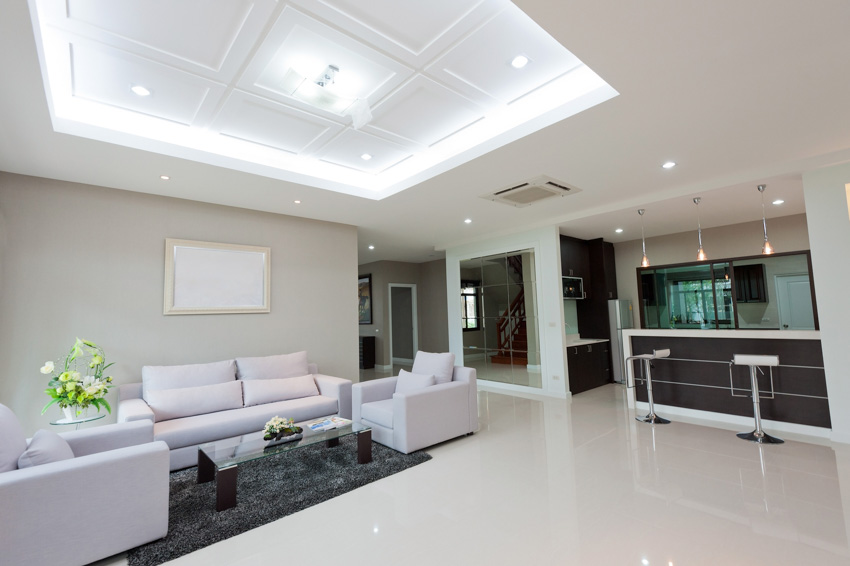
The general rule of thumb for positioning is to divide the ceiling height by 2. Hence, the amount of space to allow between each bulb is determined.
For an 8-foot-high ceiling, for instance, in-ceiling lighting spacing should be 4 feet between each light. This will allow for appropriate spacing for general lighting.
How Far Should Lights Be from the Wall?
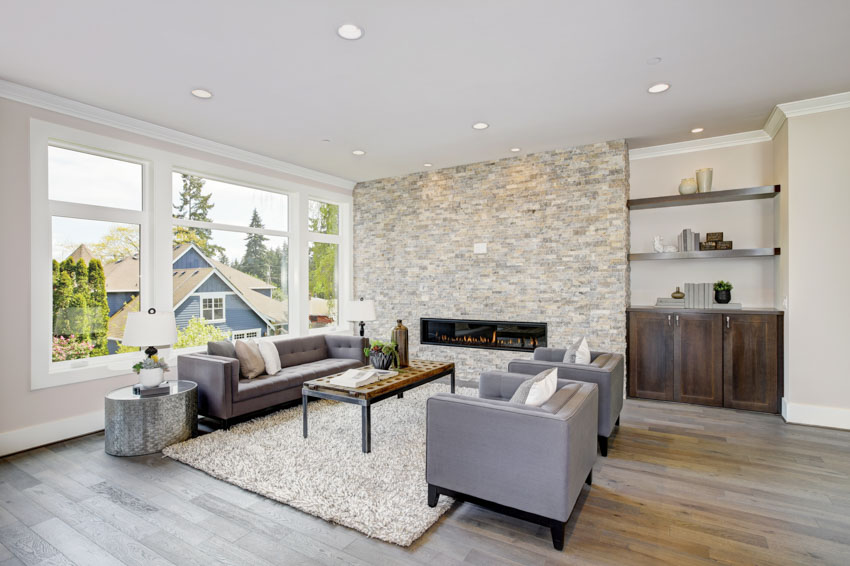
If you want to illuminate a full wall or highlight certain architectural elements or works of art, set your recessed light fixtures about 1.5 to 3 feet from the wall. If you have permanent fixtures, they should be positioned closer to the wall.
Where to Place Your Lighting Fixtures in the Living Room

With the appropriate arrangement of can lights in the living room, you can produce a wonderful, pleasant glow, and you can effectively highlight your artwork.
You can place the light fixtures 2 to 3 feet away from the walls for maximum impact.
To make any area appear optimally with can lights, ascertain proper spacing. If your living room’s ceiling is too low to provide for proper spacing, try installing a chandelier or desk and accent lights alternatively.
How to Install on Vaulted Ceilings
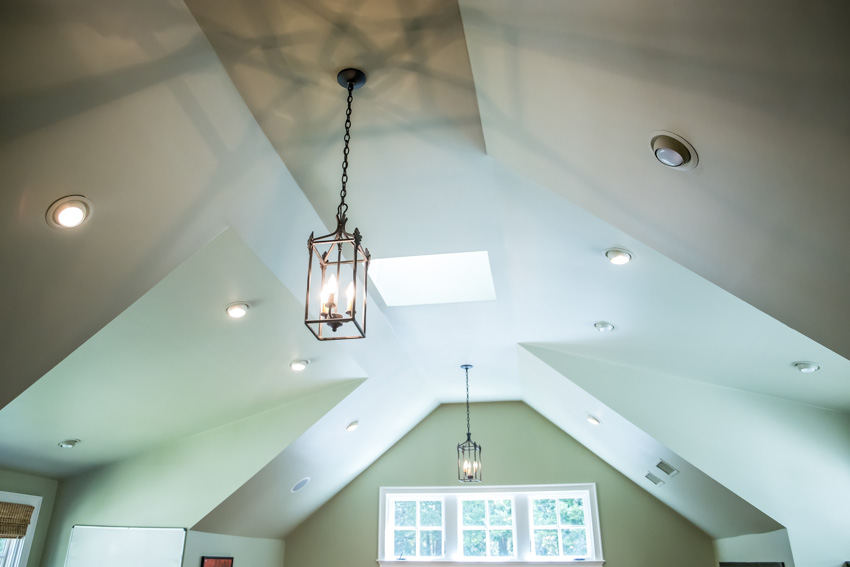
Installing and wiring recessed lights on a vaulted ceiling is nearly similar to installing recessed lights on a flat ceiling. Just take note of these reminders below:
• To make the access holes, utilize a long power drill bit.
• To make the construction quicker, add 18 supplementary inches of wire.
• Before sliding the wire through the access hole, connect it to a switch box.
Moreover, make sure to look for recessed lights that are particularly made for vaulted ceilings. Ensure that the light beam is pointing in the appropriate direction. Use an airtight fixture that will not allow condensation to develop when installing a recessed can on a vaulted ceiling.
The moisture accumulated on your ceiling can cause decay and leakage in your roof. Luckily, an airtight fixture can keep moisture away.
How Many Lights Do I Need?
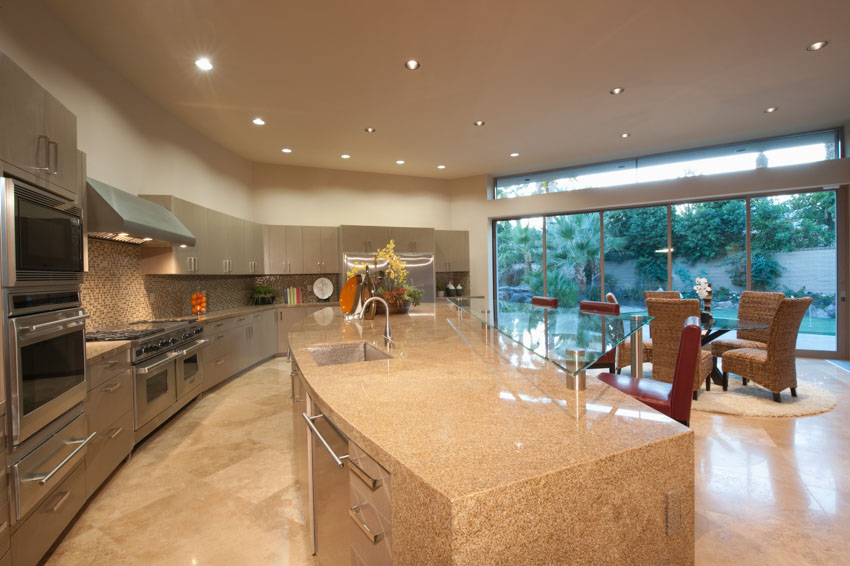
The number of recessed lights you will install will be determined by the height of your ceilings and the size of your space.
Taller and lower ceilings often necessitate the same number of recessed lights, though the higher the ceiling, the brighter the bulbs must be.
How to Change This Kind of Light Bulb
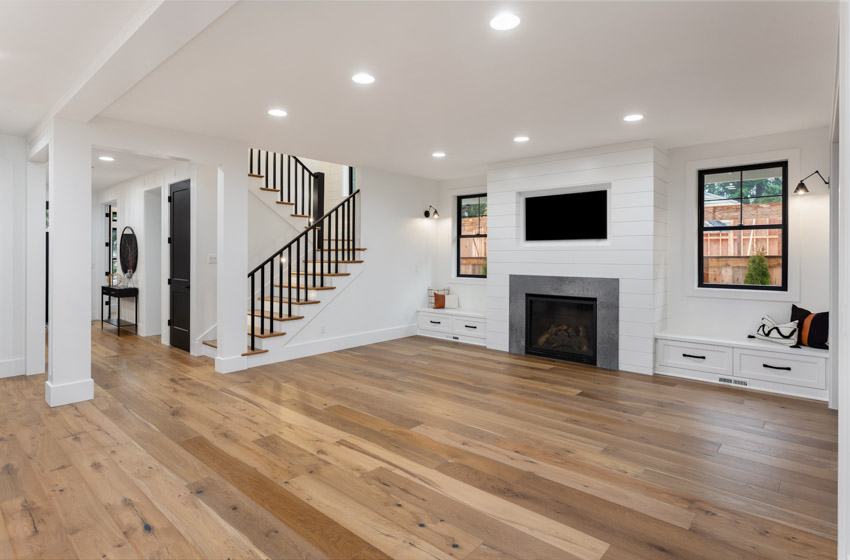
1. Wait until the light bulb has cooled completely: For a standard light bulb, this should not take more than 5 minutes. It might take up to 20 minutes to replace halogen lights.
2. Cut a piece of duct tape: The strip should be approximately 12 inches long, or half the length of your arm.
3. Fold a little piece of duct tape over and adhere it to itself: Do the same process on the other side. These folding handles must be long enough for you to grab and must have a sticky portion in between them.
4. Apply duct tape to the light bulb: Press the adhesive section of the duct tape onto the level surface of the recessed light bulb while holding the duct tape handles.
5. Unscrew the bulb by twisting it: When the tape has adhered to the light bulb, you must have enough force to pull it off.
Because nearly all light bulbs have standard screw threads, you can try to unscrew the bulb by turning it counterclockwise.
6. Complete the unscrewing by hand: Pull the duct tape off after the light bulb has extended sufficiently for you to grab the sides. At this stage, twisting the bulb out by hand is speedier.
7. Change the light bulb using the same procedure: Screw in the replacement light bulb as far as you can with your fingers. When it is nearly flat, apply the duct tape and tighten clockwise to ensure a solid fitting.
See more related content in our article about the types of dining room lighting on this page.


